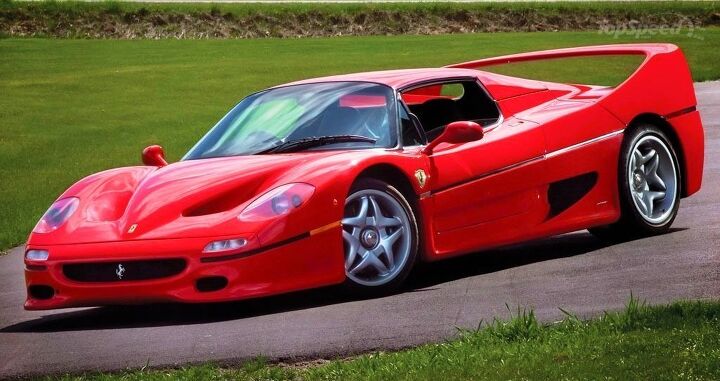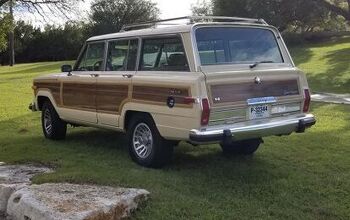Buy/Drive/Burn: Supercar Failures of the 1990s

Our recent Rare Rides entry on the Bugatti EB110 quickly sussed out a couple of mid-90s competitors in the comments section. Today, we’ll visit the trio and pick one to take home.
An entrant each from France, England, and Italy; all of them failures in their own right. Which big money flop will it be?
Bugatti EB110
When it debuted for the 1991 model year, Bugatti’s EB110 was the first new car the company produced since the early 1960s. Taking its model number from the age of the company’s founder, the EB110 dealt in some impressive numbers. A 3.5-liter V12 produced 552 horsepower via four turbochargers. A six-speed manual sent that power through all four wheels, earning it a top speed of 210 miles an hour. And it wasn’t enough. The company’s owner had an appetite bigger than his checking account could bear, and Bugatti went under for a second time by 1995.
Ferrari F50
With Ferrari’s already legendary F40 wrapping up production in 1991, Ferrari had a successor in the works. Ready for 1995, the targa-roofed machine had all the right characteristics for success. Styling was a modern interpretation of the F40’s. The engine, located amidships, was a dual-overhead cam V12 generating 513 horsepower without turbo or supercharger assistance. Not one for all-wheel drive, power was strictly at the rear. Perhaps all the expected-ness of the F50 was its issue. It didn’t try as many new things as its father, and its higher level of refinement gave it a lower level of excitement. Everyone remembers the F40 and the Enzo, but the F50 is lost somewhere in the middle.
Jaguar XJ220
The XJ220 was intended as a follow-up model to the very limited run of XJR-15s, which Rare Rides covered previously. Engineers at Jaguar worked in their free time to create a concept in 1988 that boasted 12 cylinders and four-wheel drive. The project was approved, but serious design changes were in store. The production version went on sale in 1992 with a 3.5-liter twin-turbo V6 in the middle. Paired to a five-speed manual, 542 horsepower traveled only to the rear wheels. A planned top speed of 220 miles an hour (hence the name) was not met — the XJ220 managed 212 instead. Jaguar’s project went over budget, and the £290,000 original asking price ballooned to £470,000 upon the car’s introduction in 1992. And that was right in time for the very same recession which affected sales of the EB110 above. Customers could still buy 1994 XJ220s brand new in 1997.
Three relative supercar failures; which one would you buy?
[Images: seller, Ferrari, Jaguar]

Interested in lots of cars and their various historical contexts. Started writing articles for TTAC in late 2016, when my first posts were QOTDs. From there I started a few new series like Rare Rides, Buy/Drive/Burn, Abandoned History, and most recently Rare Rides Icons. Operating from a home base in Cincinnati, Ohio, a relative auto journalist dead zone. Many of my articles are prompted by something I'll see on social media that sparks my interest and causes me to research. Finding articles and information from the early days of the internet and beyond that covers the little details lost to time: trim packages, color and wheel choices, interior fabrics. Beyond those, I'm fascinated by automotive industry experiments, both failures and successes. Lately I've taken an interest in AI, and generating "what if" type images for car models long dead. Reincarnating a modern Toyota Paseo, Lincoln Mark IX, or Isuzu Trooper through a text prompt is fun. Fun to post them on Twitter too, and watch people overreact. To that end, the social media I use most is Twitter, @CoreyLewis86. I also contribute pieces for Forbes Wheels and Forbes Home.
More by Corey Lewis
Latest Car Reviews
Read moreLatest Product Reviews
Read moreRecent Comments
- JLGOLDEN Enormous competition is working against any brand in the fight for "luxury" validation. It gets murky for Cadillac's image when Chevy, Buick, and GMC models keep moving up the luxury features (and price) scale. I think Cadillac needs more consistency with square, crisp designs...even at the expense of aerodynamics and optimized efficiency. Reintroduce names such as DeVille, Seville, El Dorado if you want to create a stir.
- ClipTheApex I don't understand all of the negativity from folks on this forum regarding Europeans. Having visited the EU multiple times across different countries, I find they are very much like us in North America-- not as different as politicians like to present them. They all aren't liberal "weenies." They are very much like you and me. Unless you've travelled there and engaged with them, it's easy to digest and repeat what we hear. I wish more Americans would travel abroad. When they return, they will have a different view of America. We are not as perfect or special as we like to believe. And no, many Europeans don't look up to America. Quite the opposite, actually.
- Dwford Let's face it, Cadillac is planning minimal investment in the current ICE products. Their plan is to muddle through until the transition to full EV is complete. The best you are going to get is one more generation of ICE vehicles built on the existing platforms. What should Cadillac do going forward? No more vehicles under $50k. No more compact vehicles. Rely on Buick for that. Many people here mention Genesis. Genesis doesn't sell a small sedan, and they don't sell a small crossover. They sell midsize and above. So should Cadillac.
- EBFlex Sorry BP. They aren’t any gaps
- Bd2 To sum up my comments and follow-up comments here backed by some data, perhaps Cadillac should look to the Genesis formula in order to secure a more competitive position in the market. Indeed, by using bespoke Rwd chassis, powertrains and interiors Genesis is selling neck and neck with Lexus while ATPs are 15 to 35% higher depending on the segment you are looking at. While Lexus can't sell Rwd sedans, Genesis is outpacing them 2.2 to 1.Genesis is an industry world changing success story, frankly Cadillac would be insane to not replicate it for themselves.




































Comments
Join the conversation
Buy Bugatti, tell inquiring gawkers its bodykit Fiero Chiron. Bugattiero. Drive Ferrari and likewise bodykit Fiero F40. Ferrariero. Each just weird, dated, and ugly enough to sometimes maybe pull hoax off. Burn XJ.
Buy - Ferrari. It still looks modern and breathtaking today, and nobody ever lost money on a rare Ferrari, did they?... Drive - Jaguar. At one point it was the world's fastest production car. This despite using the engine from the 6R4 rally version of the Austin Metro economy car (a car that was meant to replace the original Mini). To be fair, the turbo'd V6 was probably ahead of it's time given 21st century downsizing. Looks good, even the popup lights aged well. Wouldn't buy though - Jaguars aren't known for their reliability, and I'd say that Jag dealers are more used to servicing fleet XFs than a supercar. Burn - Bugatti. Yes it's rare, but those challenging looks haven't really aged well, especially since VW showed what they could really do with the marque. I'd be happier turning up outside the Monaco casino in the Ferrari or Jag.